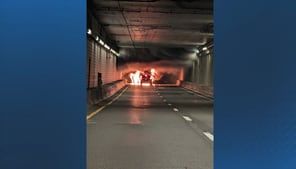Search results
People also ask
What does tunnel mean?
Where does tunneling take place?
What is tunnel construction?
Are underground tunnels used for transport?
A tunnel is an underground or undersea passageway. It is dug through surrounding soil, earth or rock, or laid under water, and is enclosed except for the portals, commonly at each end. A pipeline is not a tunnel, though some recent tunnels have used immersed tube construction techniques rather than traditional tunnel boring methods.
tunnels and underground excavations, horizontal underground passageway produced by excavation or occasionally by nature’s action in dissolving a soluble rock, such as limestone. A vertical opening is usually called a shaft. Tunnels have many uses: for mining ores, for transportation —including road vehicles, trains, subways, and canals ...
- Marmaray Tunnel, Turkey. Connecting Europe to Asia via tunnel was a nine-year process for the Turkish government. The Marmaray Tunnel—named after the Sea of Marmara that the tunnel runs through ("ray" means "rail" in Turkish)—is 47 miles long with a maximum depth of 180 feet.
- Eisenhower Tunnel, Colorado. At 11,013 feet, the Eisenhower is the highest vehicle tunnel in the world, at least according to Colorado's claims. Traversing the Continental Divide, the Eisenhower Tunnel complex moves through the Arapaho National Forest with two twin bores, both stretching just shy of 1.7 miles and at distances of 115 to 230 feet apart.
- Gotthard Base Tunnel, Switzerland. We are mere months away from having a new world's longest and deepest rail tunnel. Construction has been going on for nearly 20 years, but the Gotthard Base Tunnel inside the Swiss Alps finally will open on June 1, 2016, moving rail cars of passengers and freight between Zurich, Switzerland, and Milan, Italy.
- Seikan Tunnel, Japan. The current title holder of world's deepest and longest rail tunnel opened its 34-mile stretch in 1988 to eliminate the tricky storm-filled water passage across Japan's Tsugaru Strait.
Basic tunneling system. Tunnels are generally grouped in four broad categories, depending on the material through which they pass: soft ground, consisting of soil and very weak rock; hard rock; soft rock, such as shale, chalk, and friable sandstone; and subaqueous.
Tunnel construction is a subset of underground construction. There are three basic types of tunnel construction in common use: Cut-and-cover tunnel, constructed in a shallow trench and then covered over. Bored tunnel, constructed in situ, without removing the ground above. They are usually of circular or horseshoe cross-section.
Apr 23, 2023 · Modified date: 23/04/2023. Introduction to tunnel construction involves understanding the purpose, history, and basics of tunnel construction. A tunnel is an underground passageway that is excavated through soil, rock or both. Tunnels are used for transportation, water conveyance, sewage, and utility conduits.



